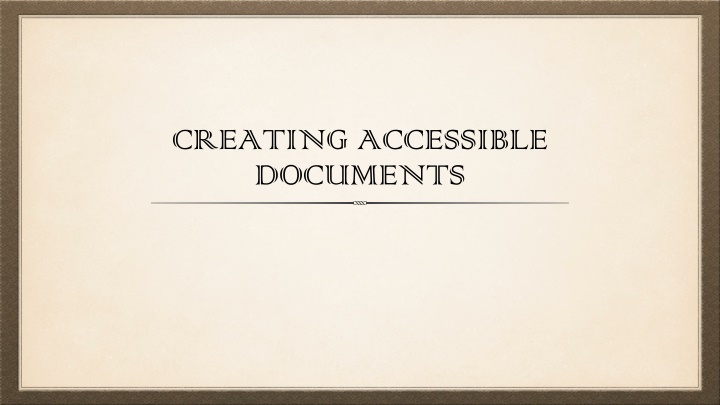
Creating Accessible Documents and Standards in Accessibility
This presentation discusses the importance of creating accessible documents, including the baseline of accessibility, compliance versus accessibility, user agency in document accessibility, and challenges with free tools like Google Docs. It emphasizes utilizing standards like WCAG, providing user control, and ensuring the inclusion of alternative text for images.
Download Presentation

Please find below an Image/Link to download the presentation.
The content on the website is provided AS IS for your information and personal use only. It may not be sold, licensed, or shared on other websites without obtaining consent from the author. If you encounter any issues during the download, it is possible that the publisher has removed the file from their server.
You are allowed to download the files provided on this website for personal or commercial use, subject to the condition that they are used lawfully. All files are the property of their respective owners.
The content on the website is provided AS IS for your information and personal use only. It may not be sold, licensed, or shared on other websites without obtaining consent from the author.
E N D
Presentation Transcript
CREATING ACCESSIBLE DOCUMENTS
HOUSEKEEPING This presentation is about creating a base line of accessibility Future revisions will likely be needed as tech improves There are still some gray areas Certain objects will still require further expert correction
STANDARDS AND RESOURCES WCAG Yes, it s a web standard, but it translates well to most electronic formats https://www.w3.org/TR/WCAG20/ Campus resources Section 508 https://www.section508.gov/create/documents/
COMPLIANCE V ACCESSIBILITY Standards and laws impose one size fits all standards that do not necessarily meet individual needs and may not evolve with new technology or understanding of human needs I will attempt to balance the competing needs and point out where conflicts may exist
USER AGENCY Some people need to change fonts due to disability or personal preference Document accessibility standards will evolve. More flexibility now means easier fixes later Let the user have as much control as possible No PowerPoint to PDF!
DONT BREAK STUFF All Microsoft products have built in accessibility features Use built in bulleted lists, headers etc IF you would use <alt> text on the web, use it in a document Use built in accessibility checkers in programs like Word and Acrobat
THE PROBLEM WITH FREE STUFF Google office is problematic for accessibility I never know if a Google doc is going to be readable and I have pretty low support needs OERs are very uneven on their enforcement of standards for authors Standards are still developing and there is still ambiguity in some areas. Some contemporary documentation is more about fixing things in the future.
<ALT> TEXT Describes the image fully so someone who cannot see will understand what it means and why it was included Skip if Purely decorative Do you really need it? Image has a good caption Image is otherwise fully described in the text Image is fully described in the the text can be acceptable <alt> text in some cases
IMAGES If an image matters, make sure it is high enough resolution to magnify well
FONTS Both serif and sans serif fonts can be accessible My personal preference is for a good serif humanist hand Stick to clean basic fonts Know that some user need to substitute fonts Open Dyslexic/Comic Sans
COLOR Text should be high contrast If you must use color, use a color blindness and/or contrast checker.
SPECIAL CASES Equations and data visualization are still problematic MathML and LaTeX are great tools Trying to get everything to play nicely can be tricky Consider creating 3-D printed models if needed
READ AND WRITE GOLD Free download to all at K-STATE Can be used to generate solid OCR for text documents that are not screen reader friendly Can read text from graphical images with limitations
TOOLS AND SUPPORT SAC Angie Brunk abrunk@ksu.edu
